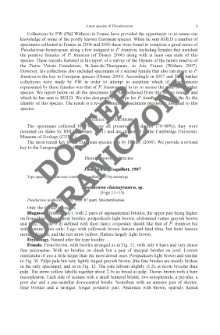- Search in all Repository
- Literature and maps
- Archeology
- Mills database
- Natural sciences
Advanced search
Advanced search
Advanced search
Advanced search
Advanced search

Object
Title: Phylogeny and classification of Zopheridae sensu novo (Coleoptera: Tenebrionoidea) with a review of the genera of Zopherinae (excluding Monommatini)
Subtitle:
Annales Zoologici / Museum and Institute of Zoology Polish Academy of Sciences, vol. 49 no 1-2
Contributor:
Muzeum i Instytut Zoologii Polskiej Akademii Nauk
Publisher:
Muzeum i Instytut Zoologii PAN
Place of publishing:
Description:
Incorrect ISSN 0001-6454 ; bibliogr. p. 50-53 ; P. 1-53. : ill. ; 24 cm
Type of object:
Abstract:
The relationships of the families Colydidae, Monommatidae and Zopheridae are examined. Phylogenetic analyses were carried out using Hennig86 and based on 37 exemplar genera from each of these families and several possible outgroups coded for 59 morphological features (42 adult and 17 larval). Results of the analyses suggest that the three families form amonophilethic group, which may be divided into two subfamilies, Colydiinae and Zopherinae, andthat the latter may be further divided into six tribes: Latometini (trib. nov.), Usechini, Monommatini, Phellopsini (trib. nov.), Pycnomerini (sens. nov.) and Zopherini (sens. nov.). The genera comprising the Zopherinae (excluding Monommatini) are keyed aout and redescribed, and general remarks are made on the biology of the family. Three new genera are described:Orthocerodes gen. nov. (type species: Sarrotrium australis Blackburn, 1891), Australia; Notorhocerus gen. nov.(type species N. valdivianus sp. nov.), Chile and Zopher (type species: Z. ivieisp. nov.), Malaysia. Type species are designated for the genera Docalis Pascoe, 1860 (D.degener Pascoe, 1860) and Elascus (E. crassicornis Pascoe, 1860). Pycnomorphus Matschulski,1858, and Dechomus Jacquelin du Val, 1859, are synonymized with Pycnomeru sErichson, 1842 (syn. nov.). Cotulades brindabellae sp. nov. is described, as is its larva. The following are also proposed: Cotulades okeinom. nov.(=C. pilosus Oke, 1932, not Docalis pilosus Carter, 1928)and C. pilosus (Carter in Wilson, 1928) (Docalis) comb. nov.
Relation:
Volume:
Issue:
Start page:
End page:
Detailed Resource Type:
Format:
Resource Identifier:
Source:
MiIZ PAN, call no. P.255, vol 49, no 1-2 ; MiIZ PAN, call no. P.4314, vol 49, no 1-2 ; click here to follow the link
Language:
Language of abstract:
Rights:
Rights Reserved - Restricted Access
Terms of use:
Digitizing institution:
Museum and Institute of Zoology of the Polish Academy of Sciences
Original in:
Library of the Museum and Institute of Zoology of the Polish Academy of Sciences
Projects co-financed by:
Programme Innovative Economy, 2010-2014, Priority Axis 2. R&D infrastructure ; European Union. European Regional Development Fund
Access:
Object collections:
- Digital Repository of Scientific Institutes > Partners' collections > Museum and Institute of Zoology PAS > Scientific Journals
- Digital Repository of Scientific Institutes > Partners' collections > Museum and Institute of Zoology PAS > MIZ PAN Publications > Annales Zoologici
- Digital Repository of Scientific Institutes > Literature > Journals/Articles
Last modified:
Oct 2, 2020
In our library since:
Jan 5, 2016
Number of object content downloads / hits:
235
All available object's versions:
https://rcin.org.pl./publication/74131
Show description in RDF format:
Show description in RDFa format:
Show description in OAI-PMH format:
Objects Similar
Ślipiński, Stanisław Adam Lawrence, John Francis
Ślipiński, Stanisław Adam Mazur, Sławomir
Matthews, Eric G. Lawrence, John Francis
Ślipiński, Stanisław Adam
Ivie, Michael A. Ślipiński, Stanisław Adam
Ślipiński, Stanisław Adam Lawrence, John Francis (1934– ) Tomaszewska, Wioletta (1965– )
Leschen, Richard A. B. Węgrzynowicz, Piotr
Bowestead, Stanley Booth, Roger G. Ślipiński, Stanisław Adam Lawrence, John Francis (1934– )

 INSTYTUT ARCHEOLOGII I ETNOLOGII POLSKIEJ AKADEMII NAUK
INSTYTUT ARCHEOLOGII I ETNOLOGII POLSKIEJ AKADEMII NAUK
 INSTYTUT BADAŃ LITERACKICH POLSKIEJ AKADEMII NAUK
INSTYTUT BADAŃ LITERACKICH POLSKIEJ AKADEMII NAUK
 INSTYTUT BADAWCZY LEŚNICTWA
INSTYTUT BADAWCZY LEŚNICTWA
 INSTYTUT BIOLOGII DOŚWIADCZALNEJ IM. MARCELEGO NENCKIEGO POLSKIEJ AKADEMII NAUK
INSTYTUT BIOLOGII DOŚWIADCZALNEJ IM. MARCELEGO NENCKIEGO POLSKIEJ AKADEMII NAUK
 INSTYTUT BIOLOGII SSAKÓW POLSKIEJ AKADEMII NAUK
INSTYTUT BIOLOGII SSAKÓW POLSKIEJ AKADEMII NAUK
 INSTYTUT CHEMII FIZYCZNEJ PAN
INSTYTUT CHEMII FIZYCZNEJ PAN
 INSTYTUT CHEMII ORGANICZNEJ PAN
INSTYTUT CHEMII ORGANICZNEJ PAN
 INSTYTUT FILOZOFII I SOCJOLOGII PAN
INSTYTUT FILOZOFII I SOCJOLOGII PAN
 INSTYTUT GEOGRAFII I PRZESTRZENNEGO ZAGOSPODAROWANIA PAN
INSTYTUT GEOGRAFII I PRZESTRZENNEGO ZAGOSPODAROWANIA PAN
 INSTYTUT HISTORII im. TADEUSZA MANTEUFFLA POLSKIEJ AKADEMII NAUK
INSTYTUT HISTORII im. TADEUSZA MANTEUFFLA POLSKIEJ AKADEMII NAUK
 INSTYTUT JĘZYKA POLSKIEGO POLSKIEJ AKADEMII NAUK
INSTYTUT JĘZYKA POLSKIEGO POLSKIEJ AKADEMII NAUK
 INSTYTUT MATEMATYCZNY PAN
INSTYTUT MATEMATYCZNY PAN
 INSTYTUT MEDYCYNY DOŚWIADCZALNEJ I KLINICZNEJ IM.MIROSŁAWA MOSSAKOWSKIEGO POLSKIEJ AKADEMII NAUK
INSTYTUT MEDYCYNY DOŚWIADCZALNEJ I KLINICZNEJ IM.MIROSŁAWA MOSSAKOWSKIEGO POLSKIEJ AKADEMII NAUK
 INSTYTUT PODSTAWOWYCH PROBLEMÓW TECHNIKI PAN
INSTYTUT PODSTAWOWYCH PROBLEMÓW TECHNIKI PAN
 INSTYTUT SLAWISTYKI PAN
INSTYTUT SLAWISTYKI PAN
 SIEĆ BADAWCZA ŁUKASIEWICZ - INSTYTUT TECHNOLOGII MATERIAŁÓW ELEKTRONICZNYCH
SIEĆ BADAWCZA ŁUKASIEWICZ - INSTYTUT TECHNOLOGII MATERIAŁÓW ELEKTRONICZNYCH
 MUZEUM I INSTYTUT ZOOLOGII POLSKIEJ AKADEMII NAUK
MUZEUM I INSTYTUT ZOOLOGII POLSKIEJ AKADEMII NAUK
 INSTYTUT BADAŃ SYSTEMOWYCH PAN
INSTYTUT BADAŃ SYSTEMOWYCH PAN
 INSTYTUT BOTANIKI IM. WŁADYSŁAWA SZAFERA POLSKIEJ AKADEMII NAUK
INSTYTUT BOTANIKI IM. WŁADYSŁAWA SZAFERA POLSKIEJ AKADEMII NAUK


































